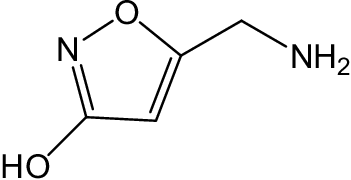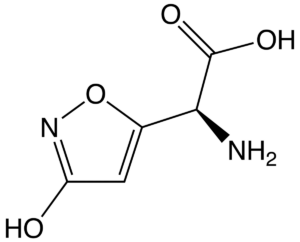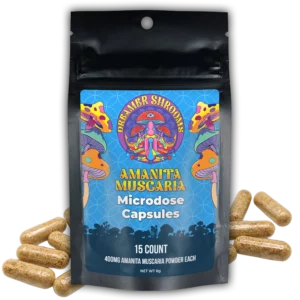
Amanita Muscaria, also known as fly agaric, has long been recognized for its potential role in alleviating depression. This fascinating mushroom has been used in various cultures for its therapeutic benefits. In this article, we will explore the understanding, historical significance, scientific exploration, mechanisms of action, ethnobotanical perspectives, comparative analysis, potential challenges and considerations, identifying and sourcing, current research landscape, and legal and ethical considerations surrounding Amanita Muscaria and its potential to improve mood.
Understanding Amanita Muscaria: An Overview
Amanita Muscaria is a distinctive mushroom with a bright red cap covered in white spots. Its vibrant appearance has captivated the curiosity of nature enthusiasts and foragers alike. Found in many parts of the world, particularly in temperate and boreal regions, this fascinating fungus has a story to tell that goes beyond its striking aesthetics.
While Amanita Muscaria is best known for its psychoactive properties, there is a hidden depth to its historical significance. Indigenous cultures across the globe have revered this mushroom for centuries, incorporating it into their spiritual ceremonies and healing rituals. The ancient wisdom surrounding Amanita Muscaria is a testament to the profound connection between humans and nature.
It is important to approach Amanita Muscaria with caution and respect. This mushroom contains potentially toxic substances, and consuming it without proper knowledge and guidance can be dangerous. The effects of Amanita Muscaria can vary widely depending on factors such as dosage, preparation, and individual sensitivity.
Delving deeper into the world of Amanita Muscaria, one discovers a tapestry of cultural significance woven throughout history. In Siberia, the indigenous people known as the Evenki have a long-standing tradition of using this mushroom in their shamanic practices. They believe that Amanita Muscaria serves as a bridge between the earthly realm and the spirit world, enabling them to communicate with their ancestors and gain profound insights.
Similarly, in parts of Europe, Amanita Muscaria has been associated with folklore and mythology. In ancient Norse mythology, this mushroom was believed to be the sacred food of the gods, granting them divine wisdom and immortality. These captivating tales add an air of mystique to the already intriguing nature of Amanita Muscaria.
Frequently Asked Questions
Amanita Muscaria should not be considered a standalone treatment for depression. It’s crucial to consult healthcare professionals for a comprehensive approach to mental health care. While traditional uses suggest mood-enhancing properties, scientific research is needed to fully understand its effects.
Amanita Muscaria contains muscimol and ibotenic acid, which affect the brain differently than psilocybin, found in “magic mushrooms.” Muscimol acts on GABA receptors, leading to its unique psychoactive effects, distinct from the serotonin receptor activity influenced by psilocybin.
Safe preparation involves drying or heating to induce decarboxylation, converting ibotenic acid to muscimol and reducing toxicity. However, specific methods vary, and it’s essential to follow guidelines from experienced practitioners or ethnobotanical sources.
The legal status of Amanita Muscaria varies by country and region. In some places, it may be legal to possess and use, while in others, there may be restrictions. Always check local laws and regulations before acquiring or using Amanita Muscaria.
Individual sensitivity to Amanita Muscaria can vary widely, affecting the intensity and nature of its effects. Factors like body weight, metabolism, and personal tolerance to psychoactive substances play a significant role. It’s advisable to start with very small amounts to gauge sensitivity and avoid adverse reactions.
The Historical Significance of Amanita Muscaria
Amanita Muscaria, also known as the fly agaric mushroom, holds a fascinating historical significance that spans across different cultures and time periods. This iconic mushroom has left its mark not only in ancient rock art but also in the rich tapestry of folklore and religious texts. Its presence in these diverse sources is a testament to the profound impact it has had on human societies throughout history.
In ancient rock art, Amanita Muscaria is often depicted as a powerful symbol of fertility and abundance. These vibrant red mushrooms with their distinctive white spots have been skillfully painted on cave walls, illustrating the reverence and importance attributed to them by our ancestors. The images convey a sense of awe and wonder, hinting at the deep spiritual connection that early humans felt towards this enigmatic fungus.
Across various cultures, Amanita Muscaria has been hailed as a sacred mushroom, revered for its potential healing properties and its ability to induce altered states of consciousness. In Siberia, the indigenous peoples have long used this mushroom in their shamanic rituals, believing it to be a gateway to the spirit world. Shamans would consume the mushroom and embark on visionary journeys, seeking guidance and healing for their communities.
Similarly, in Mexico, Amanita Muscaria holds a significant place in the ancient traditions of the Mazatec people. Known as “teonanácatl,” meaning “flesh of the gods,” these mushrooms were considered a divine gift and were used in religious ceremonies to commune with the deities. The Mazatec shamans believed that the mushroom possessed the power to reveal hidden truths and bring about spiritual enlightenment.
While the historical and cultural significance of Amanita Muscaria is undeniable, it is essential to differentiate between its traditional uses and scientific evidence regarding its potential therapeutic benefits. While it has been traditionally employed for its mood-enhancing effects, rigorous scientific studies are still needed to establish its efficacy in alleviating conditions such as depression. The exploration of its chemical composition and the mechanisms of action within the human body are ongoing areas of research, offering hope for a deeper understanding of this intriguing mushroom.
As we delve further into the historical significance of Amanita Muscaria, we uncover a captivating tapestry of human experiences, beliefs, and rituals. Its enduring presence in ancient art, folklore, and religious practices serves as a reminder of the profound impact that nature’s gifts can have on our collective consciousness. The journey of discovery continues, as we strive to unravel the mysteries of this remarkable mushroom and unlock its full potential.
Scientific Exploration of Amanita Muscaria and Its Components
In recent years, there has been a growing interest in the scientific exploration of Amanita Muscaria and its chemical components. Researchers have identified various active compounds in the mushroom, including ibotenic acid and muscimol. These compounds have been shown to interact with neurotransmitters in the brain, potentially influencing mood and cognition.
However, it is important to note that the research on Amanita Muscaria is still in its early stages, and further studies are needed to understand its mechanisms of action and potential therapeutic applications. Scientific exploration is crucial in order to separate fact from myth and to ensure the safe and effective use of this mushroom.

Muscimol, the principal psychoactive compound found in Amanita Muscaria, has captivated researchers and ethnobotanists for its unique influence on the human brain. Unlike traditional psychoactive substances, muscimol interacts with the GABA receptors, leading to its potent modulatory effects on mood and perception. This interaction is pivotal to understanding how Amanita Muscaria may offer a different pathway to mood regulation, without making direct claims about its efficacy in treating conditions like depression. The compound’s distinct mechanism of action provides a fascinating glimpse into the natural world’s potential to influence complex neurochemical landscapes, making it a subject of ongoing scientific exploration and curiosity.

Ibotenic acid in Amanita Muscaria transforms into muscimol through decarboxylation, a process involving drying or heating, which is crucial for enhancing its psychoactive effects and reducing toxicity. This highlights the significance of traditional preparation methods in safely utilizing the mushroom’s properties, marrying ancient wisdom with contemporary scientific interest.
Amanita Muscaria: Mechanisms of Action on Mood and Cognition
The mechanisms of action of Amanita Muscaria on mood and cognition are complex and not fully understood. Some studies suggest that muscimol, one of its active compounds, may interact with gamma-aminobutyric acid (GABA) receptors in the brain. GABA is an inhibitory neurotransmitter that plays a role in regulating mood and anxiety.
However, more research is needed to determine the exact mechanisms by which Amanita Muscaria influences mood. The interaction between its various compounds and neurotransmitter systems in the brain is still being explored.
Ethnobotanical Perspectives on Amanita Muscaria
The ethnobotanical perspectives on Amanita Muscaria provide valuable insights into its traditional use and cultural significance. Indigenous cultures have used this mushroom for centuries, often incorporating it into rituals and ceremonies for its potential spiritual and healing properties.
It is crucial to approach ethnobotanical knowledge with respect and caution. Traditional use does not automatically equate to safety or efficacy, and it is important to combine traditional knowledge with scientific research to understand the potential benefits and risks associated with Amanita Muscaria.
Comparative Analysis: Amanita Muscaria vs. Conventional Approaches in Mood Support
A comparative analysis of Amanita Muscaria and conventional approaches in mood support can provide valuable insights into its potential role in alleviating depression. While conventional approaches often involve pharmaceutical interventions, natural remedies like Amanita Muscaria offer an alternative perspective.
It is important to note that Amanita Muscaria is not a substitute for medical treatment. If you are experiencing depression or any mental health condition, it is important to seek professional help from qualified healthcare practitioners.
Potential Challenges and Considerations When Exploring Amanita Muscaria
Exploring the potential benefits of Amanita Muscaria comes with various challenges and considerations. One of the main challenges is the lack of standardized dosing and preparation methods. Different cultures and individuals have different ways of preparing and consuming Amanita Muscaria, which can greatly impact its effects.
In addition, sourcing reliable and high-quality Amanita Muscaria can be challenging. It is important to ensure that the mushrooms are sourced from reputable suppliers and are properly identified to prevent any potential health risks.
Identifying and Sourcing Amanita Muscaria: A Guide
Identifying and sourcing Amanita Muscaria can be a complex process. The mushroom has distinct characteristics that make it easily recognizable, but there are also other species that resemble it. If you are considering using Amanita Muscaria, it is important to educate yourself about its appearance and consult with experts or experienced foragers.
Embarking on a journey with Amanita Muscaria no longer requires the intricate process of identifying and foraging for these distinctive mushrooms, thanks to Dreamer Shrooms. Our premium Amanita Muscaria capsules and potent Amanita extract capsules are crafted from meticulously sourced mushrooms, ensuring the highest quality for our customers.
The Current Research Landscape on Amanita Muscaria and Mood Improvement
The current research landscape on Amanita Muscaria and its potential to improve mood is continuously evolving. While there is a growing interest in understanding its therapeutic potential, more studies are needed to establish its effectiveness and safety. Researchers are exploring various aspects, including its mechanisms of action, potential side effects, and interactions with other medications.
Keep in mind that the research on Amanita Muscaria is still in its early stages. It is always advisable to rely on evidence-based information and consult with healthcare professionals before considering its use for mood improvement.
Legal and Ethical Considerations Surrounding Amanita Muscaria
When exploring Amanita Muscaria, it is crucial to consider the legal and ethical aspects. The legality of Amanita Muscaria varies in different countries and jurisdictions. It is important to familiarize yourself with the regulations and laws surrounding its possession, cultivation, and use in your specific location.
Furthermore, it is essential to approach the use of Amanita Muscaria ethically and responsibly. Respect for indigenous knowledge, ecological sustainability, and individual well-being are fundamental considerations when engaging with this mushroom and its potential benefits.
In conclusion, Amanita Muscaria holds a fascinating history and potential in alleviating depression. However, it is important to approach its use with caution and to rely on scientific evidence. Always consult with healthcare professionals and be mindful of legal and ethical considerations. As the research on Amanita Muscaria continues to evolve, we can hope for a better understanding of its therapeutic potential and its role in promoting mental well-being.
-
Amanita Muscaria Capsules
$18.64 – $89.64Price range: $18.64 through $89.64Rated 4.91 out of 5Select options This product has multiple variants. The options may be chosen on the product pageClear1560120 -
Amanita Muscaria Extract + Lion’s Mane Capsules
(Extra Strength)$33.00 – $211.00Price range: $33.00 through $211.00Rated 5.00 out of 5Select options This product has multiple variants. The options may be chosen on the product pageClear1560120 -
Amanita Muscaria Extract Full Decarb
$24.25 – $168.21Price range: $24.25 through $168.21Rated 4.80 out of 5Select options This product has multiple variants. The options may be chosen on the product pageClear3.5g7g14g28g -
Amanita Muscaria Extract Partial Decarb
$19.69 – $137.30Price range: $19.69 through $137.30Rated 5.00 out of 5Select options This product has multiple variants. The options may be chosen on the product pageClear3.5g7g14g28g











